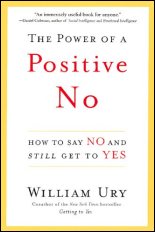 Excerpt
from The Power of a Positive No: How to Say No and Still Get to Yes
Excerpt
from The Power of a Positive No: How to Say No and Still Get to Yes
by William Ury
The Three Great Gifts of a Positive No
According to the sages of ancient India, there are three fundamental processes at work in the universe: creation, preservation, and transformation. Saying No is essential to all three processes. If you can learn how to say No skillfully and wisely, you can create what you want, protect what you value, and change what doesn't work. These are the three great gifts of a Positive No.
Create What You Want
Every day, each of us is faced with choices, small and large, where saying Yes to one choice means having to say No to others. Only by saying No to competing demands for your time and energy can you create space for the Yeses in your life, the people and activities that really matter the most to you. Here is the paradoxical secret: you cannot truly say Yes until you can truly say No.
I learned this lesson early on in my career from the well known and extraordinarily successful investor Warren Buffett. Over breakfast one day, he confided in me that the secret to creating his fortune lay in his ability to say No. "I sit there all day and look at investment proposals. I say No, No, No, No, No, No -- until I see one that is exactly what I am looking for. And then I say Yes. All I have to do is say Yes a few times in my life and I've made my fortune." Every important Yes requires a thousand Nos.
No is the key word in defining your strategic focus. Take the example of Southwest Airlines, the most successful airline in the United States and the original model for low-cost airlines worldwide. Its secret, if you think about it, is to deliver a Positive No to its customers. In order to say Yes to success and profitability (the first Yes), its strategy is to say No to reserved seats, No to hot meals, and No to interairline baggage transfers. Saying No to these three services, previously considered essential passenger benefits, enables Southwest to organize its planes for an incredibly quick turnaround at airports. This in turn allows Southwest to say Yes (the second Yes) to affordable fares and to a convenient schedule with reliable frequent flights -- the qualities most valued by its customers.
Protect What You Value
Think for a moment about all that matters to you: your personal happiness, the safety of your loved ones, your organization's success, your country's security and sound economic base. Almost everything we care about can be affected or threatened by the behavior of others. A Positive No enables us to set, maintain, and defend the key boundaries -- personal, organizational, and societal -- that are essential to protecting what we value.
Consider how one group of mothers said No to a seemingly unstoppable epidemic of teenage violence among gangs in their neighborhood in Los Angeles. Feeling utterly helpless at first, the women found strength in prayer and sallied out from church one evening into the streets, where they engaged the teenagers who were waiting for a fight to start. The women talked with their sons and nephews, offered them soda and cookies, and listened to their grievances. Surprised, the young men did not fight that night. So the mothers walked out the next night and the next and the next. Responding to the young men's concerns, they started a few small businesses and offered jobs to the youth as well as conflict resolution training. The violence in the neighborhood greatly abated. The mothers' secret was a Positive No. Their first Yes was to peace and safety, their No was to violence, and their second Yes was to helping the young men find jobs and build their self-respect.
Change What No Longer Works
Whether you are talking about making an organizational change at work, a personal change at home, or a political or economic change at a societal level, every creative change begins with an intentional No to the status quo. Your No might be to complacency and stagnation in the workplace, to dishonesty and abuse in family life, or to injustice and inequity in the larger society.
One family had a son who was destroying his life and his family's life through an addiction to gambling. So the parents and the siblings all got together one day in what is known as an "intervention" and constructively confronted the son. They began by telling him how much he meant to each of them (their first Yes) and then proceeded to tell him that he needed to stop gambling (their No) or lose their support. They invited him to seek help at a residential treatment program for gamblers (their second Yes). Faced with this Positive No, he agreed, got therapeutic help, and recovered from his addiction.
In addition to helping you say No to others, the Positive No method can help you say No to yourself. Almost everyone at times faces the challenge of saying No to temptations and to self-destructive behaviors such as excessive eating, drinking, or consuming. Often we respond by accommodating these temptations, or we attack them with self-judgment, or we simply remain in denial (avoidance) about what is going on inside us. Learning to deliver a Positive No to ourselves -- protecting our higher interests while showing respect and empathy for ourselves -- can be an invaluable aid in changing ourselves for the better.
Copyright © 2007 William Ury
